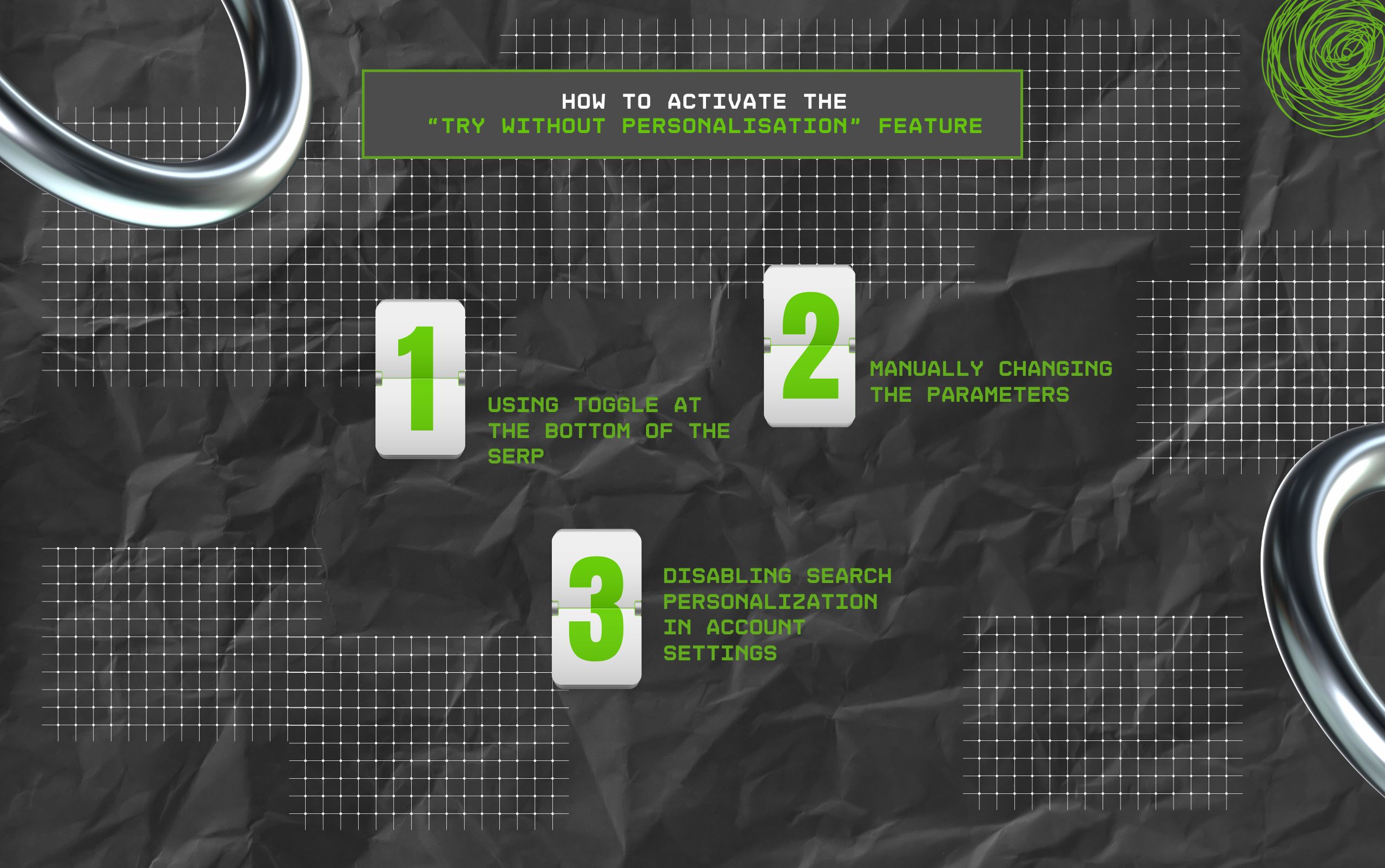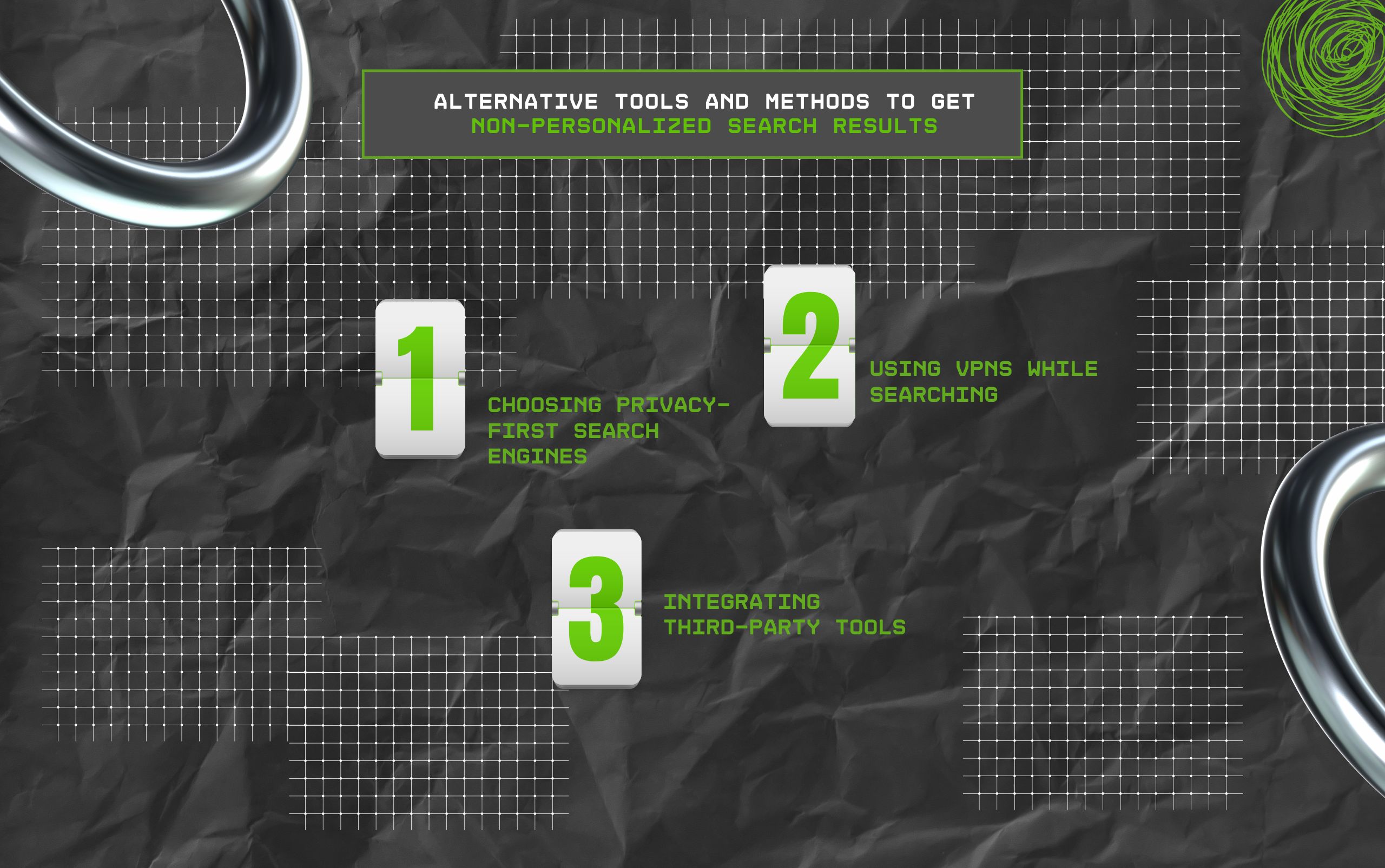What Does ML Mean In Text? Decoding The Social Media Lingo
Nov 28, 2025

Nov 28, 2025

Nov 28, 2025

Nov 28, 2025

Nov 28, 2025

Nov 27, 2025

Nov 27, 2025

Nov 26, 2025

Nov 26, 2025
Sorry, but nothing matched your search "". Please try again with some different keywords.


‣ Google’s “Try without personalisation” feature temporarily removes the user preferences from the search results.
‣ Through this feature, Google attempts to provide more transparent results and give more control to users over their data privacy.
‣ This feature offers a temporary solution to over-personalization issues — filter bubbles, search bias, and privacy concerns.
Personalization makes everything special. That’s completely true. When the user gets curated things that match their preferences, they feel seen and understood.
But too much personalization is also not good. When users get overly personalized results, there’s a high chance that they get trapped in a filter bubble.
That is, a digital cubicle that prevents them from knowing about things outside their preference lists. So, sometimes non-personalized results can break the entrapment.
Understanding this growing concern of filter bubbles and search bias, Google has launched a feature that simplifies the process to get non-personalized results.
That is, with the “Try without personalisation” toggle at the bottom of its SERPs, Google lets users control their personalized results. So, offering greater transparency and user control.
But the question is— “Is this search feature worth the hype?”
Well, that’s what I am going to debunk today. In this blog, I am going to delve into Google’s “Try without personalisation” feature and explore—
Stay tuned!
Generally, Google first introduced its Personalized Search Results in 2004 as a beta version. But later on, it integrated the feature for both logged-in and non-logged-in users around 2009.
So, based on the user’s preferred websites and search behavior, Google provides a curated SERP tailored to each user. That is, Google records user data from the searches and customizes the future search results.
Moreover, Google collects data like— user search patterns, click behavior, location, preferred websites, and more. Then, it re-ranks the SERPs specifically for the user.
So, they get relevant results on top of the page. Making the experience more personalized.
Even though personalized searches make the SERPs more relevant, they have a couple of pros and cons.
| Pros | Cons |
|---|---|
| 1. More relevant results tailored to the user’s needs and interests. | 1. Privacy concerns about the data collection process of search engines. |
| 2. Improves user satisfaction with the results. | 2. High chance of creating filter bubbles and search biases. |
| 3. Helps users find exactly what they are looking for easily. | 3. The results take time to adapt to changed interests. |
Recently, Google’s “Try without personalisation” feature has been added at the bottom of the results page. So, users can turn on and off personalized searches whenever they want.
Moreover, when users click on the feature, it automatically reshuffles the ranking articles on the page and shows “Results are not personalised” at the bottom of the screen.
That is, with the click on the feature, Google adds the “pws=0” parameter. So, all the user preferences signals are removed, and the results are non-personalized.
But it is not a permanent feature. That is, it temporarily removes the personalized touches from the SERPs. So, making it easier to prevent overly personalized results.
As the comment of the Google spokesperson, Ned Adriance, on Salar News—
“This change makes it easier for people to get an accurate understanding of whether their results have been personalized, while also providing them with the opportunity to explore non-personalized results.”
There is a growing speculation around Google’s personalized search results. That is, communities claim that Google is overly customizing results based on the user data.
Moreover, many netizens have compared Google searches’ logged-in results with non-logged-in results. And, found striking differences in the ranking pages.
So, there is a growing concern about Google’s personalized results creating filter bubbles. As Olaf Kopp claims in his LinkedIn post—
“In the last few days, I have seen a lot of examples where the search results when logged in differ significantly from those when logged out.”
Additionally, Matthias Thier agrees to the speculation in the Search Engine Roundtable report—
“Yes, it could really be stronger. I see different orders of ranking pages (ok, that’s not new, but they seem stronger to me). Sometimes, domains are completely missing in a variant. Sometimes there are Twitter boxes; in other cases, there are not. Sometimes there are video boxes that do not appear in the other state.”
Moreover, with the rising threats around data privacy and security, users are concerned about how their data is collected, analyzed, and used by the search engines.
So, by providing the non-personalization feature, Google is attempting to mitigate the concerns. That is, it is giving users more control over their data usage and providing transparent results.

To activate Google’s “Try without personalisation” feature, users can follow three simple methods—
In the first method, you can simply click on the toggle and change the personalization of the search results—

But if you want to manually change Google’s personalization, just follow these steps—
Moreover, if you want to permanently disable the personalization for Google searches, you need to change your Account settings—
To better understand how the personalized and non-personalized Google results differ, I did a little experiment.
While logging into my account, I searched for “What are the best SEO practices?”
So, my results page had personalized ranking articles from sites like Backlinko, Google Blog, Reddit Forums, and SEMrush.

But when I clicked on the “Try without personalisation” toggle, the results page re-ranked articles from SEMrush, Orbit Media, Outbrain, and more.

So, it is clear to the naked eye how the results differ from each other.
Moreover, this difference in the ranking helped me to audit the SEO performance of the websites. So, a clear comparison of the ranking order shows which site is performing better than its competitor.
Even though personalized searches provide relevant information in alignment with the user’s search interests, non-personalized searches also have countless benefits, like—
But, just like any new feature, the “Try without personalisation” comes with a few limitations, like—
Since non-personalized search results remove user preferences, Google offers insights on transparent organic ranking and SEO performance of websites. So, it is easier to do SEO audits.
Moreover, it helps in evaluating the broad visibility of the brand in a more universal context. So, if the ranking of the site drops with non-personalized results, that highlights the SEO issues.
In addition to this, the competition in non-personalized results is greater. So, the SEO aspects of the websites should be managed properly to improve ranking.
According to the uSERP report on what it truly means for SEO testing—
“For website owners, however, personalized results could be why their prospective customers find them on Search; removing it could make that harder, reducing a site’s visibility and increasing competition.”

Given that Google’s “Try without personalisation” option is not a permanent solution, here are a few alternative tools and methods to get non-personalized search results—
Firstly, users can choose privacy-first browsers like DuckDuckGo, Brave Search, Mojeek, or Startpage over Google Search. So, they can protect their data from being collected and used to modify the search results.
Alternatively, a strong VPN service can help mask the location and device details. So, Google Search cannot access this information and personalize the results page. Then, users can get all non-personalized results for the queries.
Moreover, integrating third-party tools and web extensions can minimize Google’s data collection from users. So, using TrackMeNot and uBlock Origin can help remove the user preferences from impacting the results page.
Google’s release of the “Try without personalisation” feature for its search results shows its response to users’ concerns about data privacy and search bias.
Moreover, this simple feature holds the future possibilities of providing transparent results and data control over users. So, in a way, there’s a chance of non-personalized results becoming a permanent option.
In addition to this, Google’s ongoing innovation shows that there is a chance of providing clear and simpler settings to users to manage their data online.
So, users can browse the internet without stressing about their privacy being compromised.
Now, the main question remains— “Is it worth the hype?” Well, as a temporary solution, it definitely helps in preventing overly-personalized results. So, naturally, the hype makes sense.
Also, with Google’s promising innovations in line, there is a possibility of non-personalized results becoming the search engine norm soon.
But, before that happens, use the “Try without personalisation” feature to catch a glimpse of the search results’ future.
Here are some common questions about the new “Try without personalisation” feature of Google that you can check.
Generally, there are two methods to search without personalization— using the “Try without personalisation” toggle and changing your Google Account’s settings.
For the first method, just scroll down the results page and click on the “Try without personalisation” button at the bottom. Then, the page will re-rank the articles after removing the customization.
Alternatively, you can select the Search Personalization from the Data & Privacy section of your Google Account. Then, turn off the Personalize Search button. And, you can permanently disable personalized searches.
In Google’s SERPs, the personalization option is located at the bottom of the page. So, when you scroll down to the end of the results page, you will find the button situated at the end.
To turn off ad personalization, you need to change your Google Account settings. So, simply visit the “My Ad Center” from your Account’s “Ad Settings” and turn off the personalization option. Then, confirm your choice, and the settings will be changed.
If you want to protect your data from Google, you need to change the privacy settings of your Google Account. Here are the steps—
⁍ Go to the Data & Privacy in your Google Account.
⁍ Then, scroll to Web & App activity and choose the action— autodelete, pause, or turn off.
⁍ Also, go to the Voice and Audio Activity to turn off the option.
⁍ Moreover, you can change the Location History from the Data & Privacy section.
Barsha is a seasoned digital marketing writer with a focus on SEO, content marketing, and conversion-driven copy. With 7 years of experience in crafting high-performing content for startups, agencies, and established brands, Barsha brings strategic insight and storytelling together to drive online growth. When not writing, Barsha spends time obsessing over conspiracy theories, the latest Google algorithm changes, and content trends.
View all Posts
What Does ML Mean In Text? Decoding The Soc...
Nov 28, 2025
What Does DTM Mean In Text? One Acronym, Mu...
Nov 28, 2025
What Does HY Mean In Text? Deciphering Its ...
Nov 28, 2025
Is PeopleLooker Legit? Finding Public Backg...
Nov 28, 2025
Longest Snapchat Streaks: How To Trend With Y...
Nov 27, 2025

